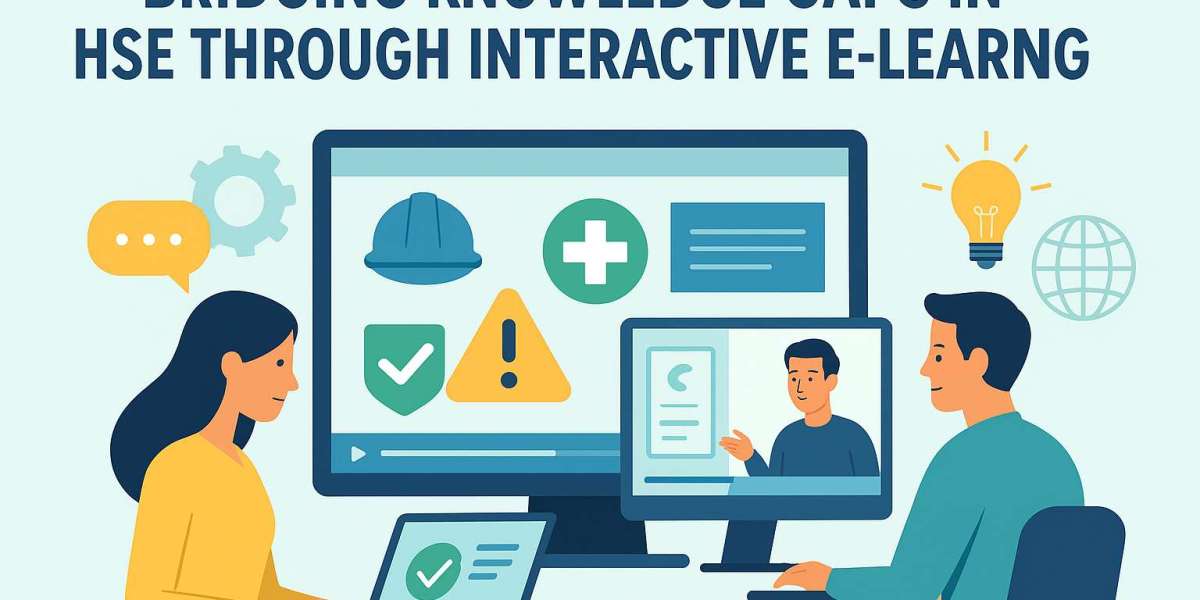Introduction
In the modern industrial landscape, robust Health, Safety, and Environment (HSE) knowledge is essential for every organization. Growing regulatory demands and the critical importance of preventing accidents make continuous training in HSE subjects vital. Workplace incident investigations and safety audits often reveal that inconsistent training is a factor, underscoring the importance of thorough HSE education. As new technologies, processes, and regulations emerge, companies must ensure that all personnel remain well-informed and competent in safety protocols. This challenge highlights the need for innovative training approaches that can reach a wide and diverse workforce effectively. Interactive e-learning has emerged as a key strategy to meet this challenge.
Knowledge Gaps in HSE Training
Knowledge gaps in HSE often arise from inconsistent or outdated training practices. Legacy training materials, infrequent classroom sessions, and language or cultural differences can leave employees with uneven levels of understanding. Typical knowledge gaps manifest in several ways:
- Training inconsistency: In-person classes or static manuals may only reach certain employees, leaving others without essential instruction.
- Rapidly changing standards: HSE regulations and industry best practices evolve quickly, and outdated materials can create gaps in knowledge.
- Accessibility challenges: Remote workers, night-shift crews, and contractors may lack convenient access to traditional training programs.
- Diverse backgrounds: Employees from different experience levels or cultures may require tailored learning approaches to fully grasp HSE concepts.
These gaps can undermine workplace safety and compliance. Without uniform knowledge, teams may unknowingly deviate from protocols, increasing the risk of incidents or regulatory noncompliance. For example, inconsistent understanding of emergency procedures or equipment handling can directly increase on-the-job hazards. Bridging these gaps is essential not only for meeting regulatory requirements but also for protecting employees and assets.
Interactive E-Learning Bridges the Gap
Interactive e-learning is a powerful solution that can close many HSE training gaps. It offers on-demand access to training materials, allowing employees to learn at their own pace and on their own schedule. This flexibility ensures that remote teams, shift workers, and geographically dispersed staff all receive the same information. Many e-learning systems can also adapt to each learner’s progress, offering extra practice on challenging topics and skipping content already mastered. E-learning platforms often include quizzes, interactive modules, and practical exercises that make complex HSE concepts easier to understand and remember.
Key advantages of interactive HSE e-learning include:
- Accessibility and Flexibility: Training materials are available online 24/7, accommodating diverse schedules and locations so that every employee can participate.
- Engagement and Interactivity: Multimedia tools like quizzes, animations, and scenario-based activities make learning more interesting and hands-on, which motivates learners to complete their courses.
- Retention and Reinforcement: Repeated exercises, immediate feedback, and interactive knowledge checks help reinforce key safety concepts and improve retention.
- Consistency and Standardization: Online courses ensure that everyone receives the same up-to-date content, reducing variability in training quality across the organization.
These features strengthen learner confidence and make important safety information stick. Many e-learning platforms also include progress tracking and reporting, enabling managers to monitor completion rates and identify any remaining knowledge gaps. When safety regulations change, content can be updated quickly to keep the training program current and compliant. By combining these interactive elements, e-learning transforms training into an ongoing process that reinforces a proactive safety mindset. Content is often available on mobile devices in short modules, enabling employees to learn in brief, convenient increments.
Role of Specialized Online Courses
In addition to general HSE courses, specialized online training tools play a crucial role in bridging specific knowledge gaps. For example, HSE auditor training online programs enable safety professionals to deepen their expertise in auditing standards and practices. These targeted courses provide comprehensive guidance on audit processes, documentation, and corrective action planning. By training internal auditors through structured online modules, organizations can ensure that audit teams have a consistent understanding of HSE auditing practices and requirements. These courses may include simulated audit scenarios that allow auditors to practice identifying hazards and proposing improvements. As a result, organizations benefit from more effective internal audits and faster corrective actions, helping them maintain high safety standards.
Conclusion
Interactive e-learning is transforming the way organizations close HSE knowledge gaps. By delivering accessible, engaging, and up-to-date training, online platforms help workers at all levels stay informed about safety and environmental protocols. Tools like HSE auditor training online demonstrate how targeted digital courses can reinforce critical skills across an entire workforce. Ultimately, this approach cultivates a consistent, audit-ready safety culture across various industries. When employees share a common understanding of safety protocols and best practices, organizations can significantly reduce incidents and maintain compliance, creating a safer environment for everyone.



